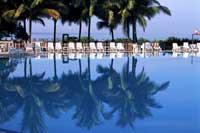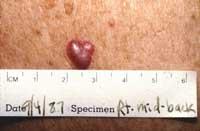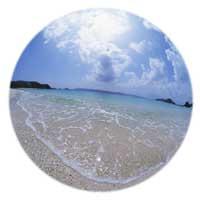Sunbathing, limits between benefits and risks

Although traveling in the history of humanity has been customary, traveling in summer is somewhat fashionable. The one who does not go on vacation is not fashionable. To be fashionable, also, you have to return tan when returning to work. What faces will they put you if not! We ignore! Not properly sunbathing can be dangerous. 5% of all radiations that reach Earth are ultraviolet, of which a maximum of 8% are type B and C that burn the skin. The rest of the radiation, light and infrared light, do not cause damage to the skin, but can increase the influence of ultraviolet. Many C and B rays are unable to filter the ozone layer, but 39% of A rays reach the surface and cause immediate pigmentation.
In the tanning process ultraviolet rays kill skin cells and alter the role of collagen and elastin. Dilation of blood vessels can also be due to ultraviolet rays, which is why after sun exposure it turns red and red. Once burned the skin is lost. If melanin changes occur, stains can also occur. Those are the consequences that can be seen almost suddenly by the sun.

When solar radiation reaches the surface, the skin against the attack has a protective mechanism. However, this protection is limited because excessive exposure to lightning prevents its maintenance. Therefore, when the protection mechanism is insufficient, protection usually requires external agents, sunray filters. Melanogenesis, the process of production and distribution of melanin, is the body's strongest protection mechanism against solar radiation. Melanins are cells responsible for skin and hair color. When ultraviolet radiation reaches the body surface, it produces melanin, causing the skin to tan. In addition to this protection, the body has others, but as the age progresses and increases the number of sun radiations are cushioned. When these protective systems are insufficient and no external protective measures are taken, the sun damages the skin. If the Sun can blush the skin and remove painful blisters, you should not worry about it, as long-term damage can be more dangerous.
Skin cancer is among the possible sun damage. There are three types of cancer of this type: melanoma, basal cell carcinoma, and squamous cell carcinoma. According to data from the American Cancer Association, in 1980 200,000 Americans suffered some skin carcinoma, ten years later 600,000, while in the case of melanoma 39,000 people. Melanoma is especially lethal, as it can cause metastasis and spread to the lymphatic system. But why has the number of people with skin cancer increased so much? It seems that time under the sun can have a lot to do with it.
The Sun can alter the DNA structure of cells. The body knows how to repair that damage, but reparation is not eternal. Marks remain because the effect of the Sun is cumulative. Therefore, the sun can premature aging of the skin of the body. This aging process is responsible for 90% of skin changes. This is a fairly representative data, which can reflect the importance of the use of a sunray protective cream.

To protect the skin against the rays of the sun it is possible to take a series of measures for its correct conservation. If necessary, the important thing is that there is not too much time under the sun. From 10 am to 2 noon it is better not to be in the sun, as that is when more radiation arrives. The protective filter, the cream, must have a wide effect, protect the skin both by UVA and UVB rays. The sun cream should be applied every two hours, especially if you have swimming between them. The days when the sky is cloudy it is also good to give it cream. In addition, dark colored cloth clothing and hat on the head also help. Try to avoid reflective surfaces, as they are able to reflect 85% of the radiation.
Once the necessary measures are taken, laws may come out. Then it is possible to have allergy to the Sun. Photosensitivity -photodermatosis - and hives are the most common allergies produced by the Sun.
Although the skin is important, often when talking about ultraviolet protection, there is nothing more to talk about, forgetting that eye protection is also important. Just as the skin is protected with creams, the eyes should be protected with sunglasses. And any glasses is not good, those that have been bought in optics have guarantee, the others do not. According to statistics, 60% of sunglasses sold do not meet quality requirements.
Protective creams, enemies of the sun

The correct use of the creams that protect us from the sun reduces the influence of ultraviolet rays and reduces the possibility of burns. But since not all creams are equal, the effect is not the same. Sunscreens, creams, are substances capable of reflecting radiation or absorbing part of it. These creams can be both physical and chemical. Physicists are mineral substances, used in the form of suspension and light cannot pass. They are able to reflect radiation. For their part, chemical-based creams are often able to absorb some of the UV rays by transforming harmful energy into safe energy.
On the other hand, the FPS factor (filter efficiency factor) appears in creams. This factor indicates how long you can stay without damaging the sun. According to experts, anyone with normal skin can remain calm for 20 minutes without suffering any sun damage. For example, FPS-15 means you can be 15 times more in the sun.
Water-resistant filters, called water-resistant, are able to withstand a 40-minute dive or two 20-minute dives. More influential are water-proof, able to withstand an immersion of 80 minutes or four of 20 minutes. Of course, just as they are water resistant, they are also sweaty.
In the choice of one or the other cream, in addition to these factors, you have to consider others: Latitude, since the solar rays are more direct in the equator than in the poles. Altitude, as the radiation is more dangerous the higher. And the reflection of the rays produced by snow and sand. It should also be noted that 90% of solar radiation is capable of penetrating fog, fog and pollution.
Published in 7
Buletina
Bidali zure helbide elektronikoa eta jaso asteroko buletina zure sarrera-ontzian











